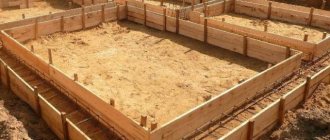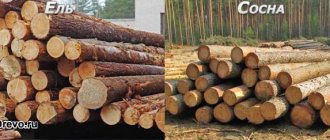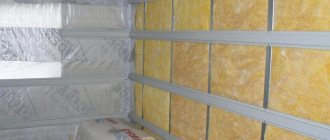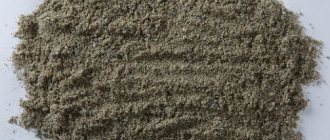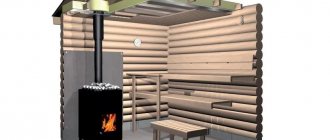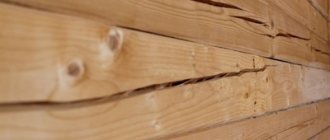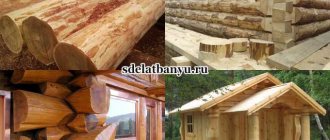Home |Construction |Which foundation is better on clay soil?
Date: November 9, 2018
Comments: 0
The basis of any structure is the foundation, which determines the service life of the construction site. The costs of arranging the foundation make up a third of the total estimated costs and it is not advisable to save on it. High-quality building materials do not always guarantee strength. The surface on which construction is carried out is of no small importance. The foundation on clay soil is fundamentally different from pouring the foundation in black earth regions.
Building a reliable foundation on a heaving foundation is a serious task. After all, it can behave unpredictably, which is associated with the ability to retain moisture and push out the building. Tricky clay is easily washed away by water, loses its integrity, and opens the way for moisture to the elements of the constructed building.
Before building on problematic soil, study its properties and decide on the type of construction. The cost of error is high. These are cracks, failures and possible destruction of the building. The construction of a capital facility in a clay soil zone requires the help of design organizations. If you plan to build an outbuilding, bathhouse or premises for a vehicle, then you can cope with this task yourself by studying the recommendations specified in the article.
The main feature of clay is the ability to quickly erode under the influence of water, without letting it penetrate deeper
Preparatory activities
If there is no choice and you have to build a foundation on clay soil, pay special attention to the following points:
- the type of clay-containing soil, which is determined during survey work involving drilling and sampling at the future foundation depth. Perform geological exploration in the spring, when the groundwater level is at its maximum, which allows for detailed research;
- the level of soil freezing for your area, which is determined for a specific region using reference information;
- moisture concentration. Humidity can be determined by leaving the sample to dry in the open air. If the process takes several hours, this indicates high humidity, causing swelling;
- the depth of aquifers located in the upper layers of the soil. Having drilled a hole and guided by the nearby well, you will assess the level of the location of the aquifers.
Let us dwell in detail on the types of clay soils.
Clay soils are called heaving soils, and before starting construction it is strongly recommended to conduct studies of the composition and homogeneity of soils on the site
Base requirements
To avoid foundation deformations, it is necessary to have information about the reasons for their occurrence. The main ones are:
- drawdown;
- bulging;
- displacement with shift.
The reason for foundation subsidence is the discrepancy between the actual supporting area and its norm. The occurrence of buckling and lateral shear is associated with incorrect foundation depth when the foundation is exposed to frozen soil.
Which clay foundation will best withstand all loads, taking into account horizontal and vertical vibrations when the soil freezes? There are not many requirements for such a foundation:
- it is prohibited to lay a foundation made of block elements;
- mandatory use of a reinforcing frame over the entire area;
- the presence of a wider sole (when compared with the upper part of the foundation);
- use of material for waterproofing the sole.
Types of clay soil
For clayey soils, a characteristic feature of the structure is the presence of microscopic plates, in the gap between which moisture is concentrated and retained. This nuance causes the soil to tend to significantly increase in volume at negative temperatures, when frozen water swells the mass and gradually displaces the foundation of the building.
You can try to knead the soil with your hand. The “sausage” of the loamy fractions will crack, and the plastic mass indicates that this is clay, which is difficult for construction.
The soil is different in different regions. Before making a foundation on clay soil, determine what kind of soil is on your site:
- Clay, which is suitable for constructing a foundation, has a homogeneous composition, and the freezing level is located above the aquifers. The plasticity of the mass and high flowability make it difficult to construct a reliable foundation for a future building.
- For example, a clay-sand mixture containing a fine stone fraction is a reliable base that is slightly susceptible to swelling.
Construction will not cause problems, and the stability and durability of the building will be ensured. Clay soils come in different varieties. If the percentage of pure clay in the soil ranges from 5 to 10, then we have sandy loam - Loams are characterized by the presence of sand, the volume of which is about 2/3 of the total mass. Depending on the percentage of clay, they are divided into heavy, medium and light types. The increased tendency to swelling complicates construction activities.
- Sandy loam containing up to 10% clay and called floating sand. As a rule, such soil moves under the influence of underground water layers and is practically not used for the construction of objects, but the use of piles allows construction on this type of soil.
- Sandstones, which contain no more than 10% of the clay mass, allow water to pass through well, are compacted under the influence of the mass of the building, and are suitable for construction.
Creation of a drainage system
If the groundwater level is high, especially if it is located above the freezing level, it is recommended to carry out drainage work before laying the foundation. They consist of forming trenches filled with gravel or a system of pipes with holes located in the ground at a slope around the future structure. Such drainage will ensure the removal of water from the foundation.
Recommendations for choosing a base
If the type of soil at a future construction site is determined, the level of water layers is known, and the freezing depth is calculated, then it is possible to choose the optimal foundation for further work. The foundation for future construction, made on a clay basis, must have high strength and resist soil reaction.
Construction specialists recommend using the following types of bases in problem areas prone to swelling:
- tape, buried to a small depth and representing a monolithic structure with an expanded sole. It is equipped when aquiferous soil layers are located below the freezing point;
Absolutely any type of foundation can be built on clay soil
- pile structure, effective when piles are deepened significantly and aquifers are located close to each other. The expansion of the lower part of the supports makes it difficult to push out the foundation under the influence of swelling forces;
- a combined strip-pile foundation, combining concrete supports and a shallow strip contour into a single frame. Used when groundwater is close to each other.
The technological features of the construction of these foundations, intended for clay problem areas, differ from those adopted for standard types of soil, since they have a complicated design and require increased financial investments. Let's get acquainted with the process of their arrangement.
Heaving soils and construction features
Soil masses that expand under the influence of low temperatures and have a destructive effect on building structure elements are classified as heaving soils. Sandy loam, loose clay and highly porous soils that are capable of retaining moisture are subject to heaving processes.
Before proceeding with the construction of the foundation, it is necessary to conduct research on the upper layers of the surface. According to the GOST description guidelines, 5 types of soil are distinguished:
- non-heaving - coarse soils, pebbles, gravel, coarse and medium sand, well-filtering liquids;
- slightly heaving soils - elevated and hilly places that are well moistened by precipitation;
- medium-heaving – slightly hilly places with long slopes, where moisture occurs by high water and precipitation;
- highly heaving - wetlands in which the situation is aggravated by the influx of groundwater;
- excessively heaving - soils of fluid plasticity and consistency, which are in a watered state due to the low density of the soil layers.
The table shows the parameters for the degree of soil heaving, but in reality, it is better to entrust the calculation of these indicators to a professional. Source kamtehnopark.ru
In the process of determining measures to prevent deformation, the corresponding coefficient is calculated.
Preparing the tape base
Foundations for buildings can be made on clay soil using a strip base. A foundation on clay soil with high humidity will be more expensive than a similar structure on a non-problem site.
It is not difficult to create a durable tape base if you use the technology performed according to the proposed option:
- Mark the construction site in accordance with the requirements of the project documentation.
- Dig a trench along the perimeter of the contour, the size of which should be 3 times the width of the future foundation, and the depth should be the freezing point.
For the construction of country houses on sandy loam and loam, with deep groundwater, you can lay a strip foundation
- Make the base 25% wider compared to its top. This will reduce the reaction from the soil, increase the support area, and prevent deformation or subsidence of the building.
- Assemble wooden, slate or metal formwork depending on the material available at the construction site.
- Fill the bottom of the trench with gravel with a layer of at least 15 cm and compact it.
- Lay a layer of sand, re-compact the sand and gravel cushion under the foundation, which will compensate for the reaction of the soil and remove excess moisture from the base.
- Cover the surface of the bottom and walls with roofing felt or plastic film to waterproof the base.
- Mount a reinforced reinforcement frame in the cavity using wire and secure its elements.
- Prepare the concrete solution according to the recipe, pour it into the formwork to the required tape height.
- Remove air pockets using fittings or an internal vibrator.
- Plan the concrete surface of the future foundation.
- After drying, cover the surface with a waterproofing coating made of roofing felt.
Deepening the monolithic strip base a meter below the level of aquifers located in the ground will compensate for soil forces and form a stable foundation for any building. Despite many disadvantages, using the advantages of clay, which can withstand significant forces from the mass of the structure, it is possible to form a strong structure for the construction of a building.
The depth of the foundation on clay soil directly depends on the clay component, the level of freezing and the occurrence of groundwater
What foundations can be built
Subject to the recommendations of SP 22.13330, even on highly intumescent soils, the construction of any type of foundation is allowed. In shallow-depth options, it is necessary to increase the thickness of the underlying layer. The pits of deep strip foundation pits and columnar foundations should be filled with inert materials that do not contain clay by default. In low grillages along the pile heads, there must be a technological gap of 20–40 cm between the ground and the beams, protected on the sides by sheet materials.
Slab foundation
The advantage of a floating slab is the largest possible support surface. Load-bearing capacity is provided by default; this design copes with uneven heaving forces without problems. However, the construction of a slab foundation on clay should be supplemented with several measures:
- underlying layer of sand, crushed stone (at low and high groundwater levels, respectively);
- ring drainage from a corrugated pipe perforated with slots in geotextiles;
- insulation of the blind area to a width of 0.6 - 1.2 m.
Heat loss through the slab, which is also a floor on the ground, is inevitable. However, this allows you to maintain positive temperatures under the entire sole. A horizontal layer of extruded polystyrene foam does not allow the clay soil adjacent to the house to freeze; drains remove moisture.
There is a modification of the slab foundation USHP (insulated Swedish slab), in which polystyrene foam is laid under a reinforced concrete structure. The USHP has a heated floor contour in the upper part. In this case, there is no heat loss through reinforced concrete. However, the insulation retains the geothermal heat of the subsoil; freezing under the house is also impossible.
Strip foundation
If the customer needs a usable basement floor, the choice of a recessed strip foundation is made by default
In this case, it practically does not matter whether construction is carried out on clay or sandy soils. There is no swelling under the sole at depths below freezing
The underlying layer has a minimum thickness of 20 cm and serves solely to level the bottom of the pit.
However, the deep-laying tape has a huge area of external surfaces:
- In winter, swelling soil presses on the underground walls from all sides;
- the interior does not allow for internal backfilling to compensate for soil pressure.
Therefore, the tape is made wider (from 40 - 60 cm), the pit sinuses are filled with sand, crushed stone, and ASG to provide a layer of at least 40 cm near the load-bearing structures.
In shallow-depth MZLF tapes, on the contrary, the area of the side faces is minimal, and tangential swelling forces are practically absent. But the uneven heaving of the soil under the sole is clearly expressed. Therefore, the construction technology changes somewhat:
- high-quality drainage at the level of the sole of the MZLF;
- insulation of the blind area + thermal insulation of the outer edges of the tape (base);
- increasing the thickness of the underlying layer to 60 - 80 cm under the concrete.
There are several reasons for this:
- a trench with non-crumbling sides can be dug exclusively in clay;
- It is impossible to make perfectly smooth walls in the ground, so the engagement with the soil will be maximum;
- During freezing, serious pull-out loads will inevitably arise.
In addition, when pouring into a trench, it is more difficult to ensure the tightness of the waterproofing layer. When laying reinforcement cages on a film laid in a slotted foundation, punctures and tears are inevitable. In this case, you can use extruded polystyrene foam as permanent formwork by securing it to the walls of the trench (suitable only for clay soils, since other soils can easily crumble at the most inopportune moment).
Pile foundation
The ideal option for complex geology and terrain of the site is the construction of a pile-grillage foundation. Regardless of the composition of the soil, the piles penetrate through heaving, unstable horizons and rest on a layer with a high bearing capacity.
Construction of a columnar structure
A pile foundation on clay soil has its advantages. When installing piles, you can enter a solid layer that is not subject to the negative influence of temperature changes and groundwater. This type of foundation is effective for nearby groundwater. Expansion of the lower part of the supports will increase the stability of the structure and its resistance to buoyancy forces. The following can be used as a columnar foundation:
- reinforced concrete pillars driven in the form of special pile fields. Reinforced concrete supports are placed in rows under main walls, in cluster groups under support columns, and individual pillars are mounted under individual racks. Grillages laid on piles unite the structure into a monolithic base;
- Bored piles are formed by preliminary drilling wells of increased diameter at intervals of 2.5 meters. They are located in the corners of the building and under the main walls. The base is filled with a sand crushed stone cushion, which is concreted with a 10-centimeter layer. Metal, polymer or asbestos-cement pipes are lowered into the cavity, which are reinforced and filled with concrete;
- Screw supports based on durable steel pipes. They are easily screwed into the ground using simple mechanical devices.
Features of the technology for laying foundations on clay
Foundations buried to shallow depths are most often laid by hand. In this case, the main thing is not to make mistakes in approximate calculations, taking into account, first of all, the degree of heaving and the bearing capacity of the soil. Based on these calculations, the dimensions of the foundation and the thickness of the cushion made of sand, crushed stone, gravel or slag are selected.
The recommended depth for laying a strip shallow foundation on clay in the conditions of our country is from 50 to 100 cm. The approximate dimensions of such a foundation are shown in Fig. 2. The above-ground part of the base should not be larger than its underground part, but may be smaller than it. The most common option is the depth and height of the foundation above the ground of 40-50 cm.
When laying the foundation, a trench is first dug. A pillow made of the selected protective material is placed at its bottom and carefully compacted. Then formwork is placed for a monolithic foundation or spacers for a prefabricated foundation, after which the mixture is poured for a monolithic foundation or blocks for a precast foundation are installed. A monolithic strip foundation should be reinforced with reinforcing metal mesh.
Before insulation, the base should be waterproofed. Foam boards are most often used as insulation. They are light, cheap, and perfectly retain air, preventing the foundation from freezing in the most severe frosts. Other thermal insulation materials are often more expensive.
Although a shallow clay foundation is not such a cheap structure, the most important thing is that with high-quality work, a building installed on it can last for many decades.
